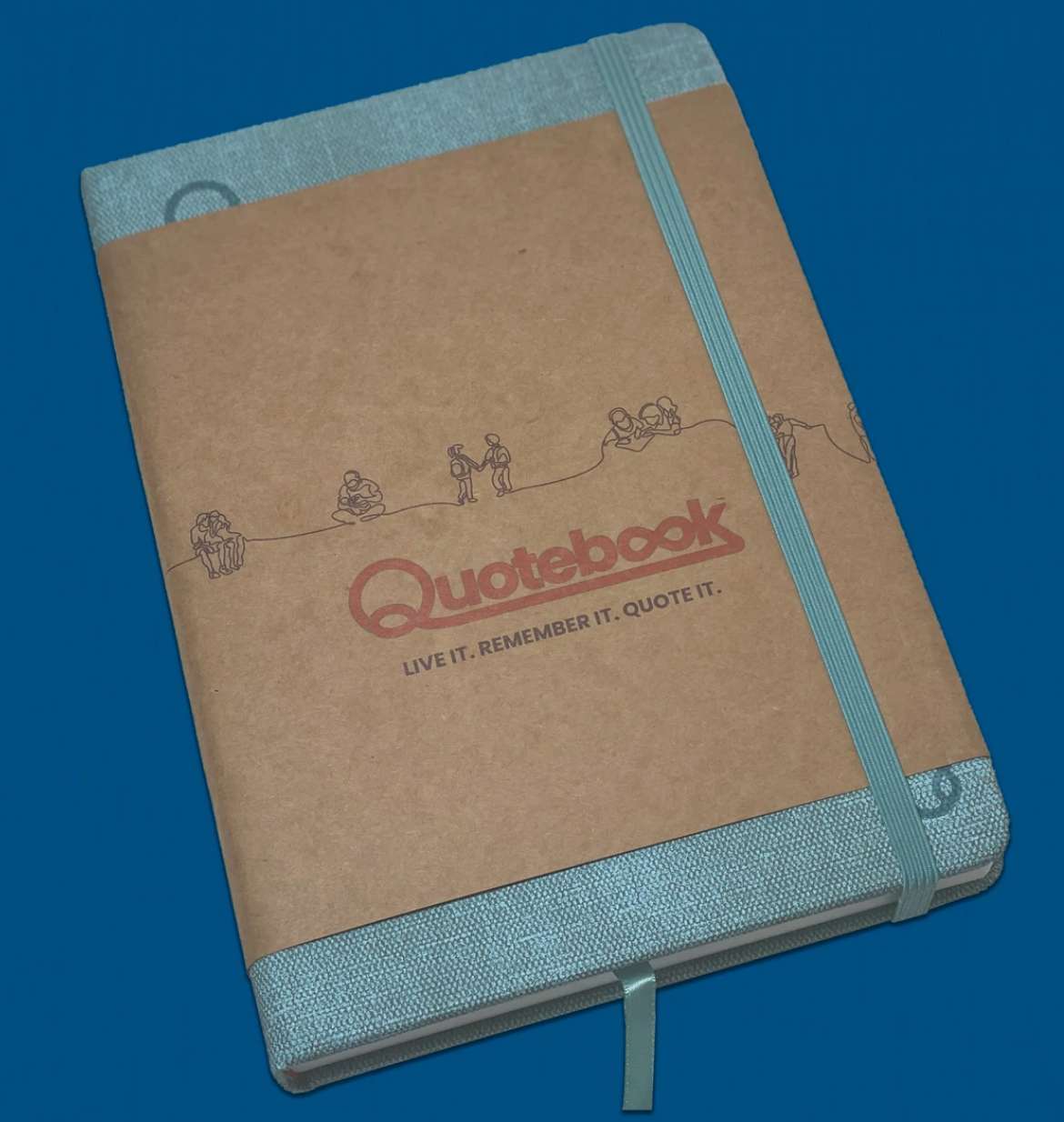Today At A Glance
- Getting stuck is common, but dealing with getting stuck is a superpower.
- Getting stuck usually comes from either not having enough options, or having too many options
- Stuck-ness is most often caused by perfectionism and uncertainty
- Find The Anitdote to stuck-ness
- Find the tools to help get out of stuck-ness
Today’s Break is brought to you by . . . Quotebook

As part of The Break Ethos, I’m a fan of using entrepreneurship and side hustles to fuel creativity and build confidence and skills that give us optionality in the future. I built Quotebook as a side hustle with my kids as a way to teach them about building.
Quotebook is an easy family journal activity where all you have to do is listen to each other and record the memorable or hilarious things that people say. My wife and I have been recording our hilariousness since 2006. Now, I give Quotebooks to everyone I know who is getting married, expecting children or becoming Grandparents.
It’s a super simple way to stay connected to the moments that matter, and they make great gifts that are sure to be remembered for years to come.
Use the code THEBREAK and get 15% off at checkout.
How To Get Unstuck
Ever felt stuck? I’m betting you have. I go through constant cycles of getting stuck. It happens on the daily, but I also tend to go through at least one BIG rut every 6 months or so. It’s a curse of multi-potentialites, anyone trying to do big things or anyone who has a wide field of vision.

The challenge is that there are so many distractions and shiny objects to chase, that we can get trapped in indecision.
So many people I come in contact with are “stuck” in their careers and stay stuck because they don’t have a process to get unstuck, or they see the energy needed to release themselves as too costly to prioritize today.
We need to break that cycle to grow.
Let’s get unstuck now.
Causes of Being Stuck
Stuck-ness comes from not “knowing” or not being able to decide, the next course of action.
I’m literally stuck writing this right now. I want to use the right words and I don’t know how it will turn out. Welcome to the two biggest causes of stuck-ness: Perfectionism and uncertainty.
Perfectionism
Perfectionists need to see a clear path before starting. That’s not the way the world works. Perfectionism leads to either less options for yourself, by dismissing things out of hand as not good enough, or creates too many options by always looking for another way to solve the problem better. Both are progress killers.
Uncertainty
Uncertainty is a paralyzer. It causes people to not act, delay or hide in fear. Unfortunately, all of life’s decisions are uncertain, and far less certain than you think. You will never be sure, but you have to act anyway. Knowing this and dealing with this is a life skill.
How Stuck-ness Manifests
Some people are stuck and don’t even know it. If you’re feeling any of the following, check in.
Fear
Anxiety
Join The Break Community
Fatigue
Jumping from idea to idea at random
Impostor syndrome (justifying why you can’t do something)
Procrastination
Depression
The Antidote to Stuck-ness

In both causes above what ends up happening when we’re stuck is we either have too few options in our head, or, interestingly, too many options.
Too few options is called tunnel vision which can be created by all the stressors above. Too many options is called overload, and can be paralyzing.
When we’re paralyzed (feeling fear, anxiousness) our creativity plummets as does our ability to see around corners and through the trees.
So the key to getting unstuck is:
- First recognize and deal with the emotion you are experiencing
- Then trace that emotion to tunnel vision (need more options) or overwhelm (need fewer options).
- Finally, select a tool to diverge (help generate) or converge (help eliminate) options.
This framework is called Diverge/Converge and it comes from the discipline of Design Thinking. More on this below.
Tools to Increase Options
Move
Exercise is the ultimate unlocker. Movement is like meditation - you focus on a singular effort and your subconscious starts working on your problem because your conscious mind has released its grip. I used to go on 6 hour bike rides as an amateur triathlete. I had some of my most creative moments on a bike. Whenever I get stuck bad my exercise level decreases as well. I can sometimes spend weeks barely exercising when I’m severely stuck. In every case I can chart the inflection point of getting unstuck to a pick up in my exercise. When I do that, my creativity starts flowing again, and my energy and excitement picks up.
Brain Hurricane
Yep, just a good ole’ fashioned idea session. Grab a white board and a partner who can stop you from eliminating ideas or being critical. No filters.
Change Frame
So much stuck-ness comes from our framing of an issue or problem. Get out of the weeds. Get an outside perspective. If it’s a customer problem, look from the distributor side. If you’re not getting considered for jobs, look at it from the hiring manager’s perspective. Seek help
Diverge
I stole this tool from the world of Human Centered Design when I worked on a project with world famous design firm, Ideo. You start by framing a hunch that serves as an anchor point to either confirm or disconfirm. Then you use “Brain Hurricane” style ideation. Aim to generate lots and lots of options. Quantity rules here, not quality. By generating lots of ideas, you’re flexing your creative problems solving skills. You may have silly ideas that come together to form very viable new ideas. You never know where inspiration will come from, so lean in.
Idea Sex
I found this tool from @jaltucher probably in 2006, and I love it so much. He has a practice of carrying around waiter pads and forcing himself to come up with at least 10 ideas per day. Anyway, back to the idea sex. This whole idea is to flex your idea muscle by looking around at great ideas and make a list by combining things.
Billion dollar companies and inventions have been hiding in plain sight. One of the best examples is luggage + wheels. Both of those things have been around for hundreds of years, but when do you think ‘wheeled luggage’ was invented? Hint: it’s younger than my dad by over 20 years.
Idea Addition
Variations of idea sex can be idea addition: taking a great idea and adding something. Paleo diet + intermittent fasting.
Tools to Decrease Options
Converge
The second half of our Design Thinking Diverge/Converge framework. Here, you lay out all of your ideas and options clearly, and systematically reduce or prioritize. The magic here is to visually stack up your options against each other. Prioritization is the process of relative selection, so seeing your options up against each other helps clarify the best ones. Pro tip: identify which ones need more clarity or information and figure out what the exact next step is that you could take to get more information and get to a quicker yes/no decision.
Warren Buffett’s version of this: He says list out your all of your top goals. Make a huge list. Then circle your top 5. You now have your top priority list of 5, and your “avoid-at-all-cost” list of everything else:)
Idea Subtraction
Sometimes we get stuck on why something can’t happen. So just remove the reason from the equation and see what happens. Take an idea that seems impossible, find the exact reason it can’t happen and remove it. I want to write a book, but don’t have a publisher —> self publish.
What if this were easy?
Famed investor Peter Thiel uses this question to figure out how to make progress on an idea way faster. The question is super helpful for perfectionists who tend to try and over-analyze and think about small details or over complicate things. The question forces you to eliminate all the “non-essential” steps and get to the tasks that will really move the needle.
If you can’t decide, the answer is no.
Finally, if you’re having difficulty deciding among alternatives, listen to your gut. If it “ain’t a hell yes, then its a hell no!” Start saying no more often and you’ll breathe easier and get out of the mud quicker. I guarantee it.
What’s happening on the pod?
Mark Hershberg dropped in to discuss his book The Career Toolkit. Mark teaches career skills at MIT and we had an amazing discussion as to why career skills trump job skill over the long term. Show notes.
Connect with Mark on his website, LinkedIn, Twitter, Facebook and Instagram.













